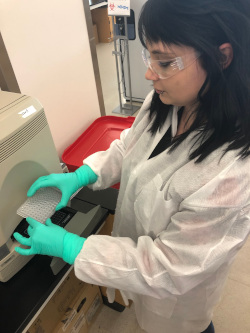
| Feb. 2019 | |||||||||||
| Top stories | |||||||||||
| In the news | |||||||||||
| Photos | |||||||||||
| Contact us | |||||||||||
| Archive | |||||||||||
|
Iowa investigates 12 norovirus outbreaks |
Feb. 21, 2019 --
Chances are that you or someone you care for may have had norovirus. Each year, more than 19 million people in the U.S. do.
 Mariah Knutson, clinical lab analyst, loads samples in to a thermocycler to test for norovirus using the polymerase chain reaction (PCR) technique.
Mariah Knutson, clinical lab analyst, loads samples in to a thermocycler to test for norovirus using the polymerase chain reaction (PCR) technique.
Norovirus is highly contagious and the bacteria can live on surfaces for days or weeks. It is the leading cause of acute gastroenteritis with vomiting, diarrhea and, possibly, dehydration. It is very common, particularly in the winter months when people tend to be indoors where illnesses are spread easily.
When the Iowa Department of Public Health (IDPH) receives a high number of reported cases or complaints, their epidemiologists may start an investigation.
The IDPH recently investigated more than 12 outbreaks of norovirus in the state with partners from the Division of Inspections and Appeals (DIA) and the State Hygienic Laboratory (SHL) to help control the spread of the outbreak by determining the suspected source of the infection, and tracking the number and location of confirmed cases.
SHL tests for norovirus in patient specimens using Polymerase Chain Reaction (PCR), a quick, sensitive and specific technique. From the suspect stool specimens, the PCR approach exponentially amplifies a segment of RNA to produce millions of copies to detect this pathogen.
“Norovirus PCR is always among our top PCR tests performed,” said Jeff Benfer, supervisor of Virology and Molecular biology. “Roughly half of the PCR testing we do is for outbreaks; the rest is per request of clinicians with a sick individual patient.
“This year there have been a lot of outbreaks reported to IDPH, and for many if not most of those outbreaks we have done norovirus PCR testing and enteric culture at SHL,” Benfer said. “A very high percentage of them have resulted in norovirus detection by PCR. So norovirus activity is very high this year.”
A comparison of the number of norovirus cases from six months in 2017-2018 (22 cases) and 2018-2019 (28 cases) shows a 30 percent increase from the last season to the current season.
More detailed information about norovirus, including symptoms and prevention, is available on the IDPH website.